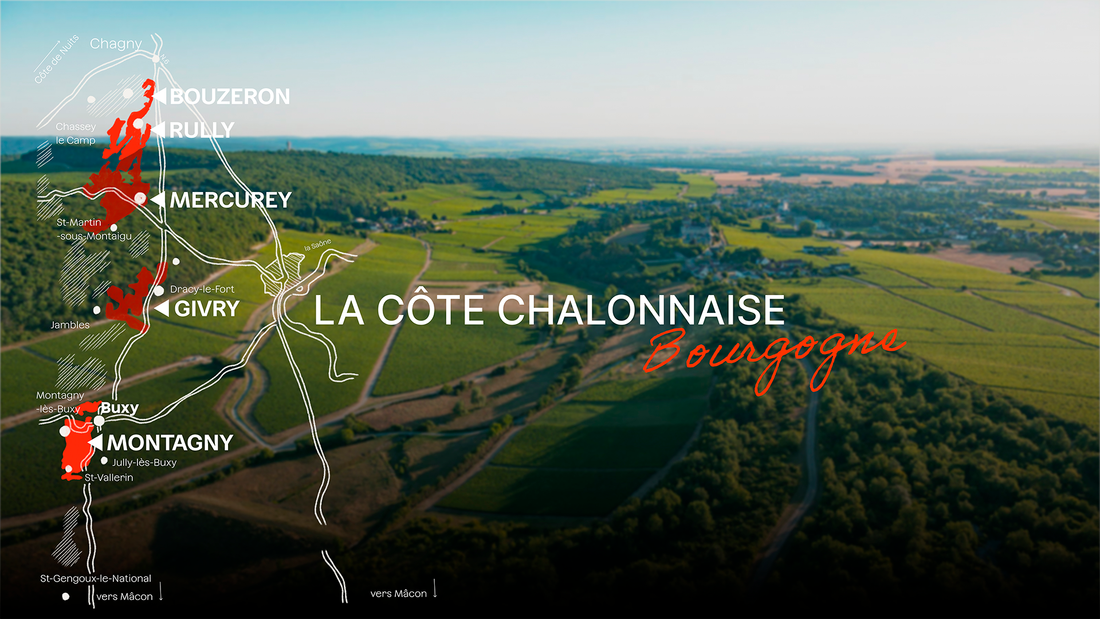

Discreet, approachable, free of bling and bombastic grands crus—but oh, so Burgundian.
The Côte Chalonnaise is that narrow strip of vines laid across limestone slopes, 25 km long and 7 km wide, where vineyards mingle with woods and fields. A mosaic of landscapes and microclimates—concentrated, vibrant, and alive. Burgundy in its natural state.
It’s home to 6 of Burgundy’s 84 appellations, a handful of premiers crus, no grands crus, but a vibrant community of inspired winemakers and talented négociants (we see you, Marthe-Henry!). This is where to come if you're looking for honest wines, trustworthy estates, still-gentle prices, and strong emotions. A freer, earthier Burgundy.
Montagny: far south, all white
At the southern tip of the Côte Chalonnaise, Montagny is a 100% Chardonnay appellation. Not a single red in sight—only whites: tender, precise, and beloved for centuries—already by the monks of Cluny. Across its 360 hectares, 52 climats are classified as Premier Cru.
Coops and négociants are present here, but independent winemakers are gaining ground. Domaine Berthenet and Domaine Feuillat-Julliot represent this new rooted generation. One to watch closely: Maxime Cottenceau, a promising young vigneron trained at Dureuil-Janthial, crafting wines of remarkable precision.
Givry: the heart, red with passion
Givry offers Pinot Noir at its most Burgundian—fresh, dense, taut, expressive. A historic appellation, already prized at the court of Henri IV.
My personal favorite? Domaine Joblot. Unmissable. Now led by Juliette Joblot, the family estate produces wines that are chiseled, deep, intense—but never showy. Alongside, Domaine François Lumpp offers a different take—more structured, sometimes austere, but with impressive aging potential.
Givry also boasts 38 Premier Cru climats and a new generation of passionate young winemakers taking up the mantle.
Mercurey: evolving greatness
The largest and most productive appellation in the Côte Chalonnaise, with over 600 hectares—one-quarter of it Premier Cru. Once known for its rustic image, Mercurey has undergone a transformation.
Vintners like Bruno Lorenzon, Laurent Juillot, and David Lefort are restoring nobility to this complex terroir of clay, marl, and limestone.
Today, Mercurey reds combine power and finesse, with ripe tannins and supple textures. The best Premiers Crus now rival those from the Côte de Beaune—except perhaps in price.
Rully: limestone freshness
Just north of Mercurey, Rully extends its vineyards across the first foothills of the Côte. Here, Chardonnay reigns supreme once again, in chiseled, expressive, and often taut whites. Pinot Noir is present, but remains discreet.
Major references: Domaine Dureuil-Janthial , which borders on excellence in both white and red and is an absolute favorite, and Domaine Paul et Marie Jacqueson , a historic pillar of the appellation. Two essential signatures.
Bouzeron: the golden islet of Aligoté
At the northern edge, Bouzeron stands apart. The only appellation dedicated solely to Aligoté doré—a more aromatic, less acidic variety that’s unfairly overlooked elsewhere.
No cheap bar wines here. Instead: saline, mineral whites with notes of citrus and dried flowers. They shine at the table.
Domaine de Villaine—led by Aubert de Villaine, co-director of Domaine de la Romanée-Conti—championed the appellation. Today, others carry the torch with flair, like Domaine Cruchandeau.
No pretense. No marketing hype.
The Côte Chalonnaise is a land of vignerons, of heritage, of patience.
You can feel the freedom of those not chasing stars but aiming true. A Burgundy less polished, more human.
For curious wine lovers, it’s a paradise—a perfect balance of price, pleasure, and personality. A Burgundy to sip with a smile and share without hesitation.


